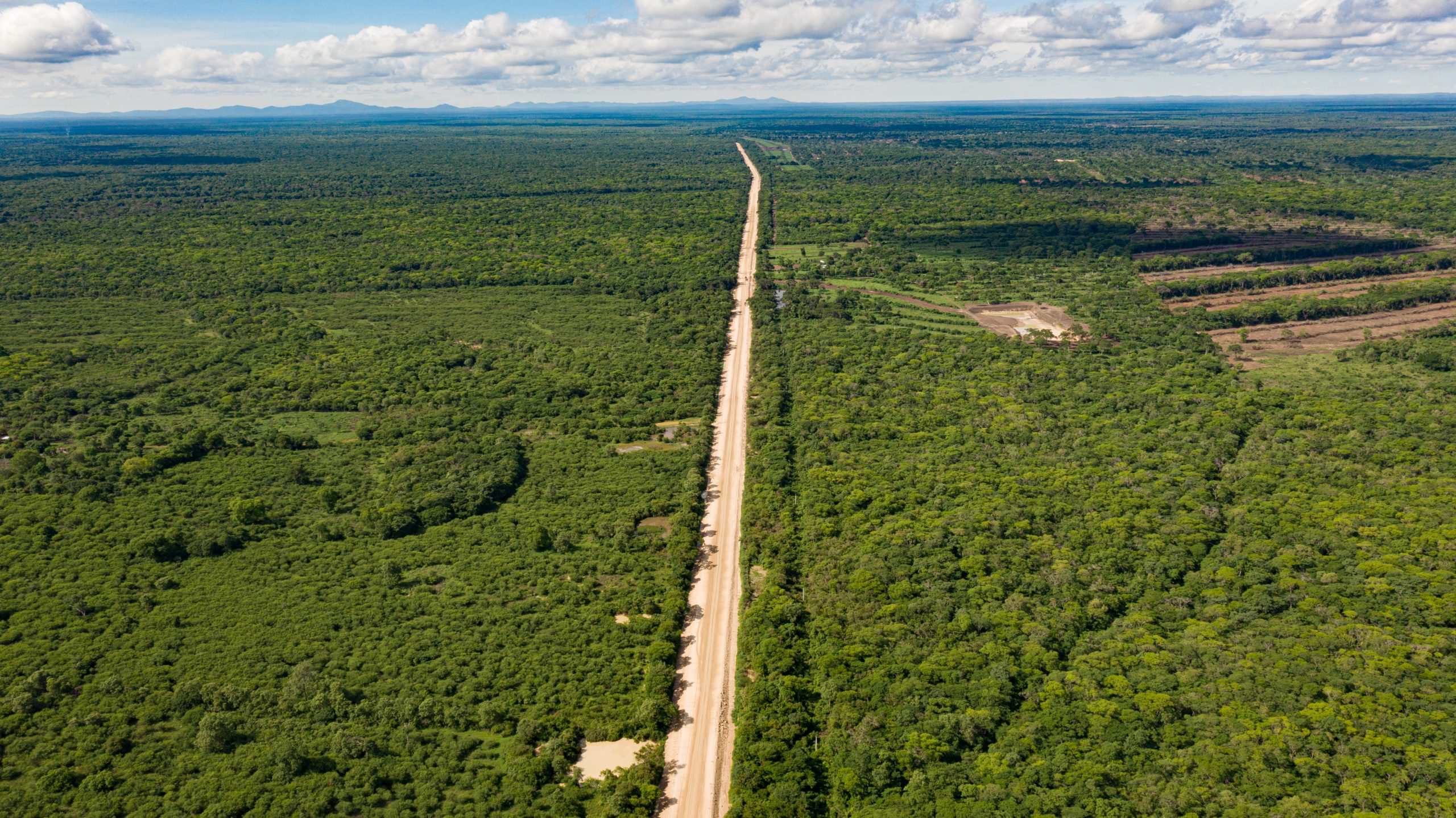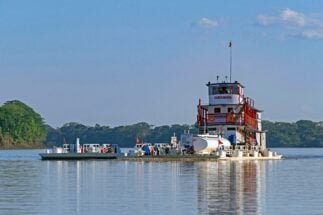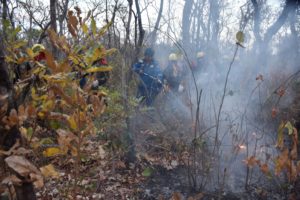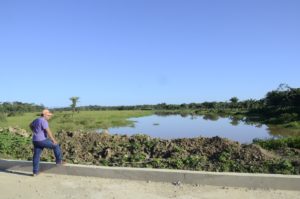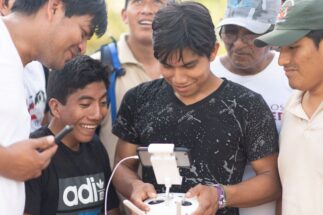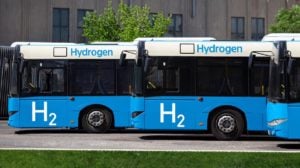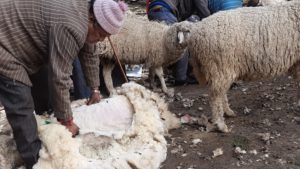The soil that Timoteo Arteaga walks on is no longer suitable for planting crops. Until about ten years ago, the 22 families who live here in San Pablo – a village in Chiquitania, a region on the transition plain between the Amazon, Gran Chaco and Pantanal biomes – grew cassava, maize, beans and bananas. But drought and a severe frost that hit the area last July ended any hope of a return to agriculture.
“Now we are ashamed to buy at the market to take back to our land, when before we used to take produce from the land to the market,” says Arteaga, who is Chiquitano, an indigenous group that has long inhabited the Chiquitania.
San Pablo is part of the municipality of San Rafael de Velasco in Bolivia’s Santa Cruz department. In this remote place, where everything seems to be deteriorating, climate change is not the only problem: a dirt road that passes through the village will soon be expanded into an asphalt highway. Although some residents welcome the promise of being connected with new economic opportunities, it is leaving a bitter taste in the mouth for others.
“It will generate more [for the] economy, but what are we going to do with the money if we can’t buy oxygen, air or forest?” Arteaga asks.
A road in Chiquitania
This area of eastern Bolivia is little known to the world, but is of great ecological importance. The Chiquitano dry forests cover more than 24 million hectares, almost entirely in Bolivia and, to a lesser extent, Paraguay and Brazil. It is the largest tropical dry forest in South America and one of the best preserved. However, the construction of the new road, financed by a World Bank loan and built by the China State Construction Engineering Corporation (CSCEC) – the world’s largest construction company – is raising fears for its future.
When the contract with CSCEC was signed in 2018, it was reported that the Chinese company would deliver the project in 36 months – by 2021. But progress has been slow and it is not yet 20% complete. Political and social conflicts in Bolivia, changes in government, wildfires and the Covid-19 pandemic have proved to be significant obstacles.
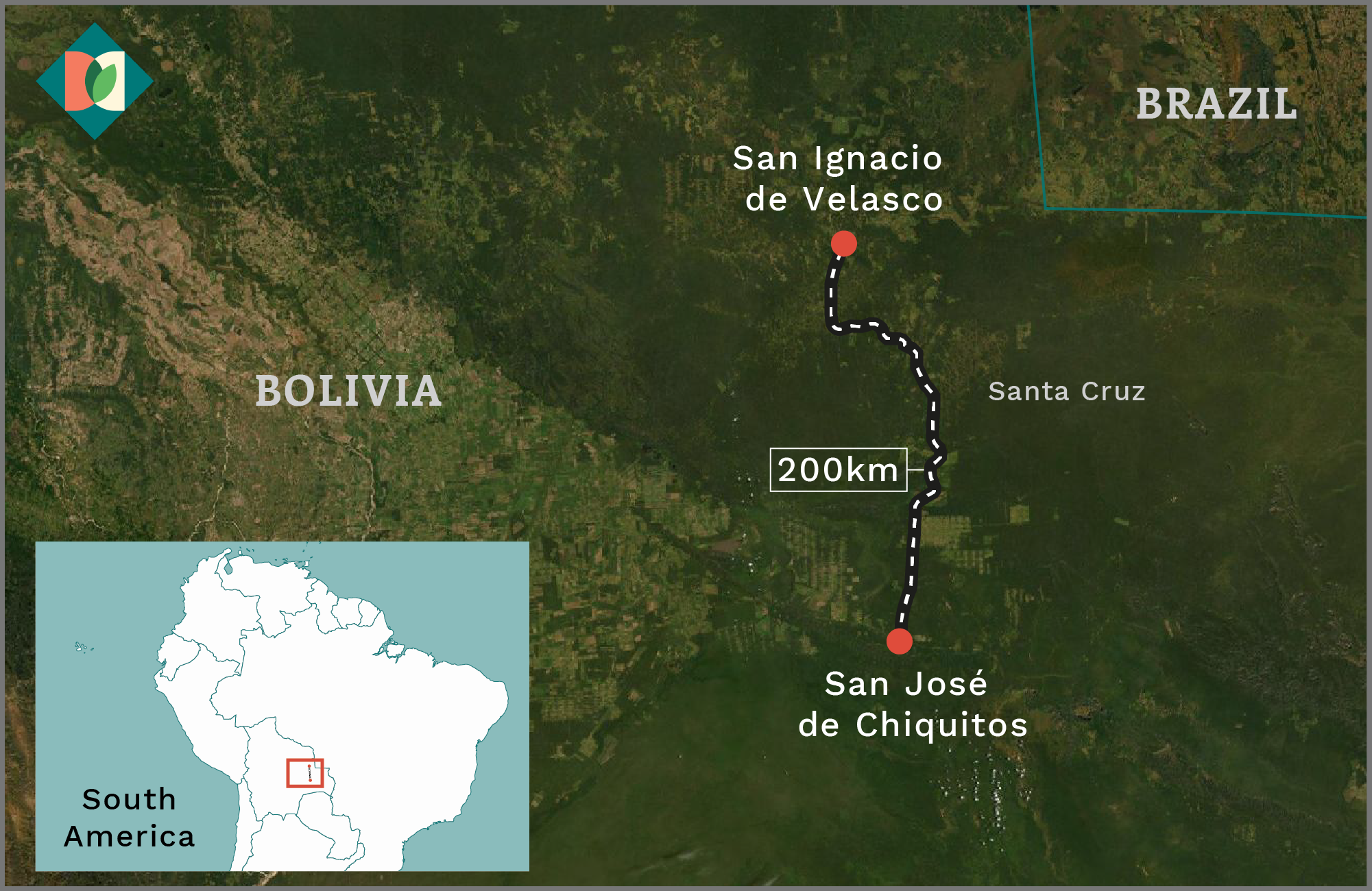
Work began in September 2019 on the existing route, which links the municipalities of San José de Chiquitos and San Ignacio de Velasco, to widen and extend it to a 208-kilometre asphalt highway. Coincidentally, that same year saw some of the last decade’s biggest forest fires. Santa Cruz was the worst affected department nationwide, with 4.2 million hectares of forest burned.
Like many roads and large-scale projects, the implementation of the project has become a subject of heated debate. Some see it as a dream, others believe it will only benefit cattle ranchers, farmers and traders, but not indigenous communities, who have fewer vehicles and products to take to faraway markets. They are asking for fair compensation for the damage the project will cause to an area already struggling in the face of a changing climate, and demand that their right to a free, prior and informed consultation on works on their ancestral land be respected – something they say has so far been violated.
Taking land and water
“They [the construction workers] were taking water out of the water pools that accumulate on the [dirt] road during the dry season,” says Antonio Suárez Viera, president of the San Ignacio committee. “They have left the communities without water.”
Such accusations are repeated in the community of San Antonio, in San José de Chiquitos. According to the villagers, their water pools were used for construction without permission or consultation. Diálogo Chino and the inhabitants of the Chiquitania requested comment from the offices of Bolivia’s highways administration (ABC, in the Spanish acronym) in Santa Cruz and in the capital La Paz but received no reply.
Yet, water is not the only problem. In total, 16 indigenous communities will be directly affected by the project: seven in San Rafael and three in each of the other municipalities the road crosses. All of them are located next to the road, prompting unease.
In some cases, schools are located next to the road, putting pupils who will have to cross an asphalt highway at risk. In others, they will have to relocate completely, along with the places where the communities rear their livestock. In San Rafael, the road splits the town in two. Jorge Vargas, the mayor, told Diálogo Chino that he is also concerned about the environmental impacts that this work will generate, estimating that “at least 2,400 hectares will be affected”.
Biologist Juan Carlos Catari said: “In the case of deforestation, a lot of fauna – mainly monkeys and small mammals – need the forest to be uninterrupted in order to move around.” He also noted that the Chiquitano forest contributes to two major river basins in South America: the Amazon and the Río de la Plata.
Richard Rivero, an environmental engineer who specialises in protected natural areas, warns that in the construction of a road, the impact is greater in the operational stage than in the execution stage. “There is the issue of accidents, the running over of animals, and the greater atmospheric pollution caused by the circulation of vehicles. This part is more important and we have to pay a lot of attention to it,” he said.
Demanding benefits from the World Bank
An official ABC document states that the environmental license, granted to allow construction, dates from 2011, with a revision made in 2016.
The project got off the ground in 2017, when Bolivia received a US$230 million loan from the World Bank, and in 2018, the China State Construction Engineering Corporation (CSCEC) was awarded the contract to build the road. Once completed, the San José-San Ignacio route will form part of the network of the Bioceanic Corridor that links Chile, Bolivia and Brazil – from the Pacific to the Atlantic.
But the validity of the license and construction have long been doubted by the communities affected. Fernando Rojas is the cacique (leader) of the Association of Indigenous Communities of San Ignacio de Velasco (ACISIV). He rose to the position after questioning the road project for several irregularities, such as the lack of prior consultation. “The ABC held a public exhibition in the mayor’s office instead of carrying out a prior consultation with the indigenous peoples,” he says. “Nobody asked us anything.”
Since 2015, the indigenous leadership has demanded that the ABC comply with legal procedures. In the absence of meaningful engagement, representatives managed to convince World Bank officials to come to the site in 2018 to start negotiations on the issue and an Indigenous Peoples’ Plan (IPP).
An IPP is a World Bank framework for implementing projects in areas where indigenous peoples are affected, in order to ensure that there are benefits for these groups, and to avoid or mitigate adverse impacts. They may sometimes include financial compensation. “It compensates for some of the damage that is being generated. It [the IPP required] is of a broad nature because the road is not only affecting one community, but others indirectly, which is why it is intended to be inter-communal,” explains Alcides Vadillo, director for eastern Bolivia at the NGO Fundación Tierra, and an expert in indigenous peoples’ rights.
There was no consultation with indigenous peoples. Nobody asked us anything.
At the time of writing, a final meeting was expected between the World Bank and indigenous peoples in the four affected municipalities to sign the agreements. Travel restrictions due to the pandemic, however, have not allowed it. Despite this, the communities are ready to present their projects to the bank and receive their IPP payment. San Ignacio, San Rafael and San Miguel will invest money into community centres where they can have administrative offices, meeting rooms and accommodation to receive visitors, while San José plans to invest in agricultural projects, handicrafts and drilling wells to protect the increasingly scarce water supply in the forest.
Time will tell on road benefits
Despite others’ concerns, Luisa Are, treasurer of the community of Miraflores in San Rafael, says she has already begun to feel the benefits of the road. “The families here have seven, eight children, many are single mothers and with this construction we are getting some money. For example, the workers pay us to wash their clothes,” she says.
Before construction began, the World Bank assured that the road would benefit 125,000 inhabitants, 61% of whom identify as indigenous Chiquitano and, to a lesser extent, Ayoreo. The Bolivian government also promoted the project with a publicity campaign that spoke of boosting agricultural trade and tourism.
However, for Silvia Molina, a civil engineer and researcher at the Centro de Estudios para el Desarrollo Laboral y Agrario (Cedla), the road will only reinforce an economic model based mainly on the expansion of the agricultural frontier and cattle ranching. She is wary of the project and fears for the future of the Chiquitania: “It is a whole process in which the region is no longer defined by those who inhabit it, but by companies and land traders.”
This report was produced with support from Bolivian environmental news outlets La Región and Red Ambiental de Información.
